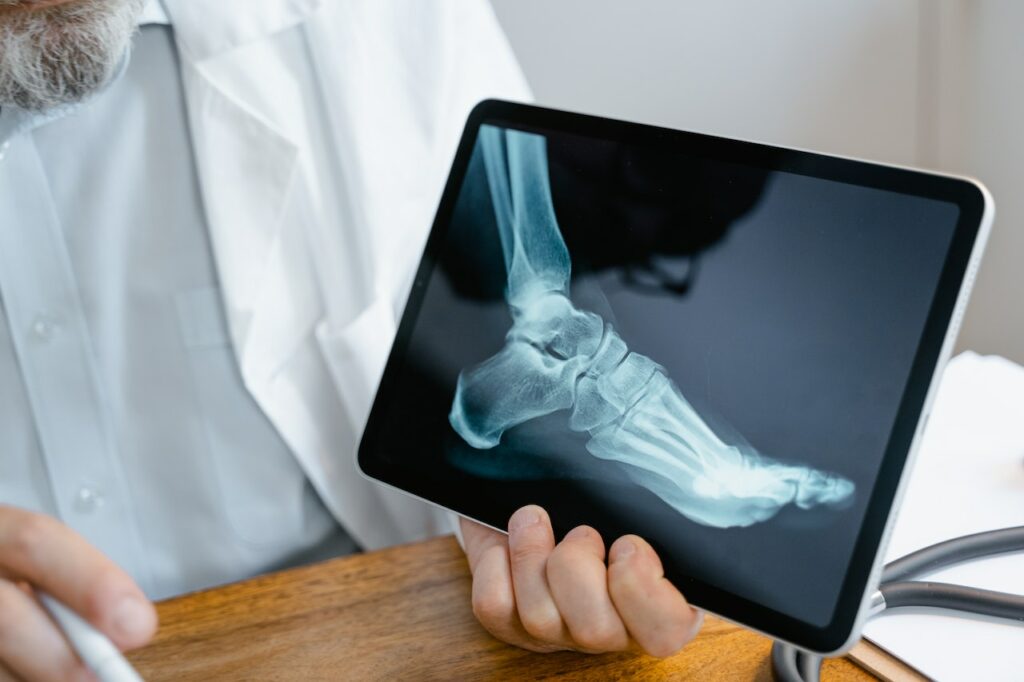Many individuals who’ve experienced a fracture often ask whether they need physiotherapy.
This article aims to shed light on this subject by providing a comprehensive understanding of the role of physiotherapy in the healing process post-fracture.
The short answer is that everyone suffering from a fracture would benefit from at least one session with a physio to get the advice they need for a faster recovery (and to prevent complications down the line).
Understanding Fractures
A fracture is a break or a crack in a bone, which can occur in various forms such as simple, compound, greenstick, or comminuted fractures.
The nature of the fracture significantly influences the recovery process.
Thus, understanding the type and severity of the fracture is vital to plan an effective rehabilitation strategy.
Role of Physiotherapy After a Fracture
Physiotherapy, also known as physical therapy, involves methods to improve movement and function, relieve pain, and promote better health by utilising physical techniques.
Physiotherapy plays a crucial role in the recovery process post-fracture.
After a fracture, the affected area often experiences reduced movement and strength due to immobilisation. Physiotherapy helps restore this lost function by encouraging movement, reducing pain, and strengthening the affected area.
It also aids in speeding up the healing process by enhancing circulation and reducing the formation of excessive scar tissue.
Benefits of Physiotherapy Post-Fracture
Physiotherapy has numerous benefits following a fracture. It aids in pain management, reducing reliance on pain medication.
By promoting movement and strength, physiotherapy enhances the functionality of the affected limb, enabling patients to regain independence more quickly.
Additionally, physiotherapy can help mitigate complications such as muscle atrophy, joint stiffness, and blood clots.
Furthermore, studies have shown that patients who undergo physiotherapy after a fracture recover their pre-injury levels of activity and function faster than those who do not.
For example, in a study published in the ‘Journal of Orthopaedic & Sports Physical Therapy’, patients with ankle fractures who engaged in physiotherapy showed improved mobility and balance compared to those who did not.
The Process of Physiotherapy After Fracture
Physiotherapy after a fracture typically involves several stages, from initial pain management to gradual restoration of function.
The physiotherapist will tailor the programme to the individual’s specific needs and progress, starting with gentle movements and gradually introducing more complex exercises.
Manual therapy, hydrotherapy, or even technologies like ultrasound may be used as part of the treatment.
Common Fracture Treatments Used by Physiotherapists
Understanding the different treatments used by physiotherapists for fracture recovery can further underscore the importance of physiotherapy post-fracture.
Here are some commonly used treatments:
- Range of Motion Exercises: Once the bone has healed adequately, physiotherapists usually start with range of motion exercises. These are designed to slowly improve the movement of the affected limb, working through any stiffness that might have developed during immobilisation.
- Strength Training: This typically begins once the patient has regained some range of motion. Physiotherapists guide patients through specific exercises designed to strengthen the muscles surrounding the fracture, which not only aids in recovery but also helps prevent future injuries.
- Balance and Proprioception Training: Especially important for lower limb fractures, these exercises help regain balance and coordination, which are often impaired following a fracture.
- Pain Management Techniques: Physiotherapists use various techniques such as manual therapy, ice and heat therapy, and even therapeutic ultrasound to help manage pain.
- Functional and Activity-Specific Training: Physiotherapists guide patients through exercises that mimic their daily activities, like walking, climbing stairs, or gripping objects, to ensure they can return to their normal life as smoothly and quickly as possible.
- Education and Advice: Perhaps one of the most valuable aspects of physiotherapy is the advice and education provided by the physiotherapist. This can include guidance on how to move safely, advice on what to expect during recovery, and strategies to manage pain at home.
When to Start Physiotherapy After Fracture
The right time to start physiotherapy post-fracture often depends on the type and location of the fracture, and the individual’s overall health status.
In general, physiotherapy may commence soon after the fracture has been treated, with the aim to prevent complications.
However, it’s crucial to consult with a healthcare professional before starting any physiotherapy programme.
Long-Term Outcomes of Post-Fracture Physiotherapy
Engaging in physiotherapy after a fracture can significantly influence long-term health outcomes.
By improving mobility and function, it can reduce the likelihood of long-term disability.
On the other hand, neglecting physiotherapy might result in complications such as chronic pain, reduced mobility, and a decline in overall quality of life.
Common Myths About Physiotherapy After Fracture
Some common myths about post-fracture physiotherapy include the belief that it’s only needed for severe fractures, or that it’s too painful.
However, even minor fractures can benefit from physiotherapy, and a good physiotherapist will work within the patient’s pain tolerance, focusing on gradual and consistent improvement.
Conclusion
In summary, physiotherapy is indeed necessary and beneficial after a fracture.
It plays a crucial role in enhancing the healing process, restoring function, and improving long-term outcomes.
While every individual’s situation may differ, it’s highly recommended to consult with a healthcare professional about the potential benefits of physiotherapy post-fracture.
FAQs
- Can I do physiotherapy at home after a fracture? A: Yes, but it should be under the guidance of a professional physiotherapist who can provide a personalised home exercise programme.
- How long will I need physiotherapy after a fracture? A: The duration of physiotherapy depends on various factors like the type of fracture, your overall health, and your personal recovery rate. Your physiotherapist will be able to provide a more accurate timeline.
- Can physiotherapy help with fracture-related pain? A: Yes, physiotherapy can help manage and reduce fracture-related pain through various techniques such as exercises, manual therapy, and advice on pain management strategies.
